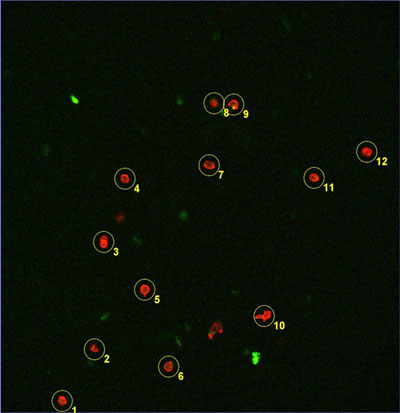| Posted: September 1, 2009 |
Chip detects microorganisms in ambient air |
|
(Nanowerk News) Microorganisms are active everywhere, even in places where food is produced or processed – but not all are desirable. Researchers can now test the air directly in production halls or warehouses for potentially dangerous microorganisms.
|
|
Microorganisms are everywhere, but many can be destructive – for example, in the production and processing of food. They can cause food to perish or alter its taste, e.g. by disrupting the fermentation process when making cheese. Until now, testing ambient air for these microorganisms has been expensive and time-consuming, and traditional microbiological processes have reached their limits.
|
|
Researchers from six Fraunhofer Institutes have now developed a test system capable of carrying out such tests on the spot and in less than half an hour.
|
 |
| The fluorescent marking of the antibody causes the bound test particles -which fit like a key in a lock - to emit a red glow (Image: Fraunhofer IPM)
|
|
“We take a plastic chip and apply a gel to it. We embed special fluorescent-marked antibodies in this gel. These detect very specific microorganisms which can then be viewed under a fluorescence microscope,” explains Gerd Sulz, project manager at the Fraunhofer Institute for Physical Measurement Techniques IPM in Freiburg.
|
|
The test system monitors the ambient air by accumulating different microorganisms and particles – including dust – on the gel, and segregating only particles between one and ten micrometers in size. The antibodies in the gel bind to specific microorganisms, which fit into them like a key in a lock. They do not bind to specks of dust or other germs. The task of the Freiburg scientists is to detect the identified microorganisms using an optical technique.
|
|
|
|
The first step is a wash cycle that removes all the antibodies not bound to microorganisms. This is done by applying an electrical voltage – the unbound antibodies are so small that they can be moved through the gel by the electric field, whilst the antibodies that have latched onto a microorganism remain trapped. A glance at the chip reveals whether any antibodies, and how many, have bound to microorganisms – the trapped antibodies glow red due to the fluorescent marking. The result provides information about the type and number of potentially dangerous microorganisms in the air.
|
|
A prototype of the test system has already been built. The researchers have used it successfully to carry out measurement cycles with relevant test particles and are now working on software to fully automate the process. The researchers will be presenting the test system at the Anuga food trade fair in Cologne from October 10 to 14 (Hall 5, Stand B020).
|

